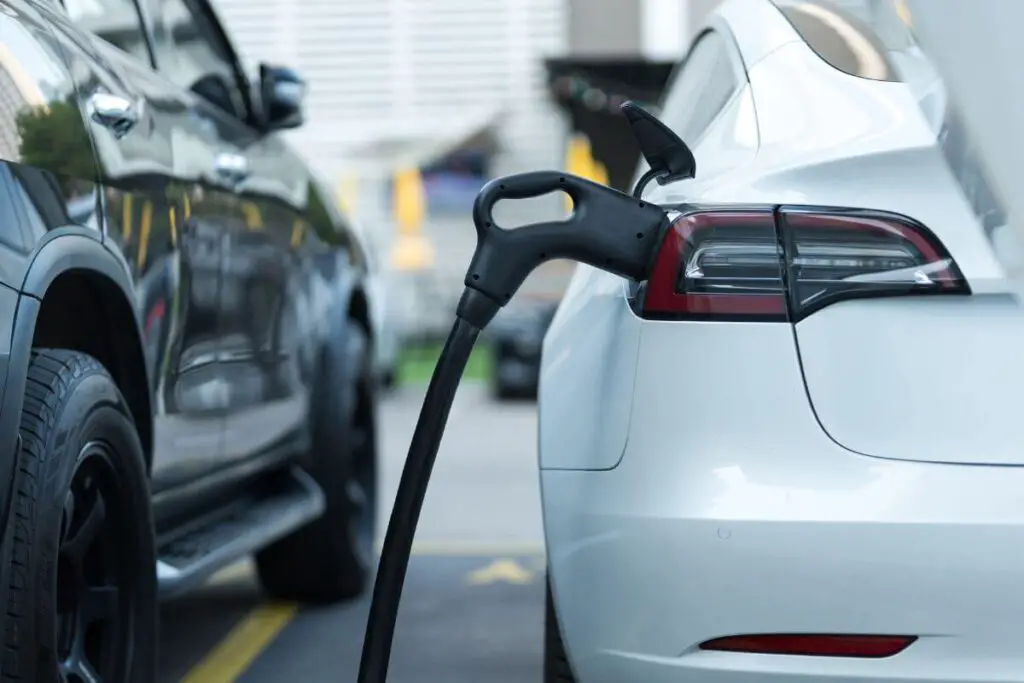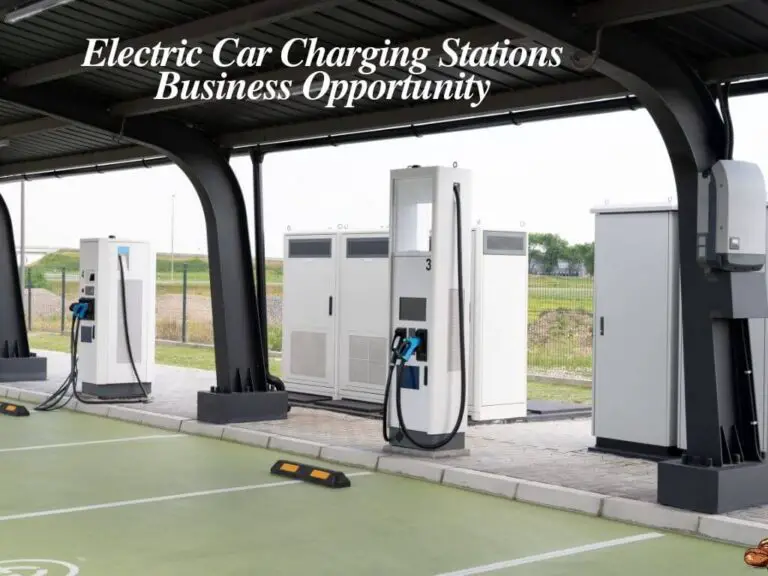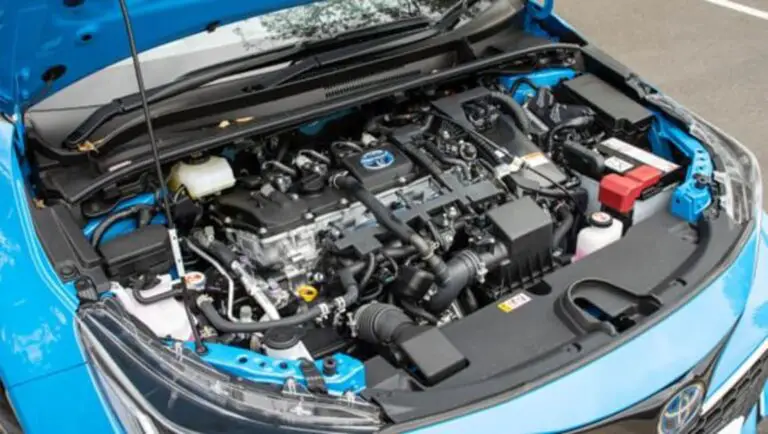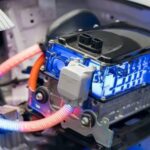Yes, electric cars have water pumps. These components are crucial for battery thermal management.
Electric cars, rapidly evolving and reshaping the automotive landscape, embrace the necessity for efficient cooling systems to ensure optimal performance and longevity. Water pumps in these vehicles circulate coolant, helping to regulate the temperature of the battery pack and other electronic components.
Unlike traditional internal combustion engines, electric cars rely on this cooling system not for engine cooling but for maintaining the ideal operating temperature of their electrical systems. As battery performance is sensitive to excessive heat, the sophisticated thermal management facilitated by water pumps is essential. By keeping everything running cool, electric vehicles can deliver reliable power, safeguard battery life, and provide enhanced safety for passengers. As the electric vehicle market grows, understanding the critical role of components such as water pumps becomes increasingly important for consumers and the automotive industry alike.
Electric Car Cooling Essentials
When diving into the world of electric vehicles (EVs), it’s vital to understand the role of their cooling systems. Unlike their combustion-engine counterparts, EVs require a different approach to heat management. In these innovative vehicles, maintaining an optimal operating temperature is key to ensuring efficiency, performance, and longevity. So, do electric cars have water pumps? The short answer is yes, but with nuances and components unique to the needs of an electric powertrain.
Importance Of Temperature Regulation In Electric Vehicles
Temperature regulation is paramount in electric cars for multiple reasons. The high-powered electronics, including the battery, motor, and inverter, are sensitive to heat and can lose efficiency or sustain damage if temperatures rise too high. An effective cooling system mitigates these risks, ensuring peak performance and reducing wear on critical components. Proper temperature control also plays a significant role in maximizing battery life and range, a top priority for EV owners.
Overview Of Cooling System Components
The cooling system in an electric vehicle is a sophisticated network of components each designed to tackle specific cooling needs:
- Electric water pumps: Vital for circulating coolants through the system, these pumps are controlled electronically, allowing for precise management.
- Heat exchangers: These function to transfer heat away from the battery and electronics.
- Thermal interface materials (TIMs): They enhance the transfer of heat between surfaces.
- Refrigerant-based systems: Some EVs use systems similar to air conditioners to provide additional cooling capacity.
Together, these components ensure that temperatures remain within ideal limits to protect the vehicle’s key systems and extend its usable lifespan.

Impact Of Water Pumps In Evs
When we delve into the technological intricacies of electric vehicles (EVs), water pumps emerge as critical components few may consider. These unassuming players have a profound impact on the efficiency and longevity of EVs. Let’s explore how water pumps contribute to the thermal management of electric vehicles, compared to the cooling mechanisms of their combustion-engine counterparts.
Role Of Water Pumps In Electric Vehicle Cooling
Electric vehicles rely on advanced thermal management systems to keep their battery packs, power electronics, and motors operating within an optimal temperature range. This is where water pumps come into play. Unlike traditional vehicles, which use air and liquid for cooling, EVs primarily depend on a liquid cooling system that requires an efficient circulation of coolant. Water pumps are the heart of this system, moving the thermal fluid through various components to absorb and dissipate heat effectively.
- Regulation of Battery Temperature: Enhanced battery performance and lifespan through precise temperature control.
- Cooling of Power Electronics: Reliability and efficiency in power conversion units are maintained with consistent thermal conditions.
- Motor Temperature Control: Motors operate cooler, ensuring peak performance and preventing overheating.
Comparison With Traditional Combustion Engine Cooling Systems
Water pumps in EVs present a stark contrast to the cooling systems found in combustion engines. Traditional vehicles utilize a water pump driven by the engine itself, making it mechanically dependent on the engine’s operation. This means the pump’s effectiveness is tethered to engine speed, often leading to inefficiencies during idle or low-speed conditions.
Electric vehicles, on the other hand, boast electronically controlled water pumps. This grants them the flexibility to adjust flow rate according to the cooling demands in real-time, irrespective of the vehicle’s speed. The result is a more energy-efficient process that contributes to the overall sustainability and cost-effectiveness of EVs.
| Feature | Combustion Engine Cooling System | Electric Vehicle Cooling System |
|---|---|---|
| Driving Mechanism | Mechanical | Electronic |
| Efficiency at Low Speed | Lower Efficiency | Highly Efficient |
| Impact on Performance | Can Affect Engine Performance | Optimal Performance Maintenance |
Thermal Management In Electric Vehicles
One of the lesser-known yet critical aspects of electric vehicle (EV) technology is thermal management. While it’s common knowledge that electric cars run on high-powered batteries instead of traditional gasoline engines, not everyone considers how these vehicles deal with the heat generated during operation. Thermal management in EVs is vital not just for ensuring passenger comfort but more so for maintaining battery efficiency, longevity, and safety. Let’s delve into how electric cars tackle this challenge.
How Electric Cars Manage Heat Generation
Electric cars employ varying strategies to control the temperature caused by their electric components, primarily the battery, motor, and power electronics. While they may not have the complex cooling requirements of a combustion engine, EVs still need to dissipate heat to function optimally. Active thermal management systems, often involving a liquid coolant that circulates through components, are common. This not only removes the heat efficiently but also maintains a uniform temperature across the battery cells.
Air-cooling systems, while simpler and cheaper, are generally less effective at heat management but can be found in select EV models. Additionally, heat pumps, somewhat similar to air conditioners, are increasingly employed to serve dual purposes; they cool the EV’s battery when temperatures climb and warm it when outside temperatures drop.
Different Types Of Cooling Systems Used
The sophistication of an EV’s cooling system depends largely on the vehicle model and the specific performance requirements. Understanding the varieties can reveal much about a vehicle’s efficiency:
- Liquid Cooling Systems – Circulating a coolant through channels in the battery pack, absorbing and then dissipating heat via a radiator.
- Air Cooling Systems – Passing air over the battery surface or through internal channels to remove excess heat.
- Phase-Change Material – Using substances that absorb heat as they change from solid to liquid, inherently controlling temperature.
- Thermoelectric Cooling – Converting thermal energy directly into electrical energy to provide cooling.
- Heat Pumps – Reversible systems that can heat or cool the batteries by transferring heat to or from the surrounding environment.
The choice between these systems revolves around striking a balance between efficiency, cost, and complexity. Liquid cooling stands out for its effectiveness but adds weight and complexity to the vehicle design. Meanwhile, more basic air cooling may suffice for lower-range, less performance-intensive electric cars. Regardless, each system plays a crucial role in extending the lifetime of the vehicle and ensuring safety during operation.

Water Pumps In Battery Cooling
With electric vehicles (EVs) rapidly gaining popularity, understanding the components that keep them running efficiently is essential. One such component is the water pump, an unsung hero that plays a crucial role in battery cooling. As electric cars do not have a traditional internal combustion engine, they don’t need a water pump for cooling the engine. However, they do employ water pumps in innovative ways to ensure the optimal performance of their batteries. Let’s explore the function and importance of water pumps in the context of electric car battery temperature management.
Function Of Water Pumps In Maintaining Battery Temperature
Battery efficiency and longevity are directly linked to temperature control. Too much heat can result in decreased performance and even damage to the battery cells. Water pumps circulate coolant to remove excess heat, thereby maintaining the battery at an ideal operating temperature. This thermal management is critical, especially during rapid charging or high-performance driving when the batteries heat up quickly. The water pump is responsible for the continuous flow of coolant, ensuring that the heat is evenly distributed and dissipated away from the battery cells.
Examples Of Electric Cars With Water Pumps
Many prominent electric vehicles on the market feature sophisticated cooling systems that include water pumps to regulate battery temperature:
- Tesla Model S and X: These models utilize a highly efficient liquid cooling system to keep the battery pack within the optimal temperature range.
- Chevrolet Bolt EV: Chevy’s electric hatchback uses an active thermal management system with a water pump for consistent battery temperature control.
- Nissan Leaf: Later versions of the Leaf enhanced their battery longevity with the addition of a thermal management system that includes a water pump.
Apart from these examples, most modern electric vehicles employ a similar approach to battery cooling, recognizing the vital role that water pumps play in the overall health and efficiency of the vehicle’s power source.
Evolution Of Electric Car Design
The Evolution of Electric Car Design is a testament to the rapid advancement in automotive technology. Electric vehicles (EVs) have transformed dramatically from their early prototypes to the sleek, efficient, and high-performance models we see today. The journey of this transformation includes significant changes in various vehicle components, perhaps none more intriguing than the cooling systems. Unlike traditional internal combustion engine vehicles, EVs demand different approaches to maintain optimal operating temperatures, leading us to the critical role of water pumps in their engineering.
Changes in cooling system requirements over time
Changes In Cooling System Requirements Over Time
The cooling system in any vehicle plays a vital role in ensuring the engine operates within the right temperature range. In the case of electric cars, the need for cooling has evolved substantially. Early electric vehicles didn’t generate as much heat as their modern counterparts, and as such, the cooling requirements were relatively minimal. But with the introduction of more powerful batteries and faster charging times, the heat generated during these processes increased. Bold updates to the cooling systems became essential to prevent overheating and to guarantee long-term battery efficiency and safety.
Over time, the cooling system requirements have seen a shift from passive air-cooled designs to more complex liquid-cooling systems. This change is primarily because liquid coolants can transfer heat much more efficiently than air. This evolution necessitates the introduction of an integral component: the water pump.
Integration of water pumps in modern electric vehicles
Integration Of Water Pumps In Modern Electric Vehicles
The integration of water pumps into the design of modern electric vehicles is a critical development. These pumps circulate coolant through the batteries, power electronics, and other heat-generating components to maintain an optimal temperature. As a result, they are central to the car’s longevity and performance.
Contemporary electric vehicles often employ multiple water pumps for different cooling circuits. These may include a primary circuit for the battery pack, and secondary circuits for the motor and power electronics. Some high-performance EVs even adopt sophisticated variable-speed pumps that can adjust flow rates according to the specific cooling demands at any given time—this modularity in cooling ensures significant energy savings and can extend the vehicle’s drive range.
The water pump’s ability to operate at variable speeds also means that they can respond dynamically to the vehicle’s cooling needs, making them highly efficient and necessary for today’s electric vehicle architecture. As we look towards the future of electric vehicles, the refinement of cooling systems, including water pumps, continue to be an area ripe for innovation and improvement.
Silent Heroes: Water Pumps In Evs
When we envision electric vehicles (EVs), images of sleek designs and quiet motors often overshadow the critical components working silently under the hood. Among these unsung heroes are the water pumps, essential yet often overlooked players in the EV ecosystem. Far from their traditional role in internal combustion engines, water pumps in EVs serve a pivotal function in maintaining the overall health and efficiency of these green machines.
Unseen But Essential: How Water Pumps Contribute To Ev Efficiency
In the world of electric cars, efficiency is paramount. While these vehicles have shed many of the mechanical parts of their gas-guzzling predecessors, the need for thermal management remains. Water pumps play a vital role in this process, circulating coolant to regulate the temperature of high-value components like the battery, power electronics, and electric motor.
With precise temperature control, the potential for overheating plummets, leading to enhanced performance, longer battery life, and improved safety. Additionally, well-regulated systems demand less power, thus extending the range of the EV on a single charge.
- Coolant circulation to manage high temperatures
- Battery longevity through consistent thermal conditions
- Safety enhancements by reducing the risk of overheating
Innovations In Electric Car Water Pump Technology
As EVs evolve, so do their components. Innovations in water pump technology reflect a commitment to sustainability and performance. Energy-saving designs are now commonplace, with pumps operating only when necessary, thereby minimizing power consumption. Some water pumps boast of variable flow rates, adapting to cooling needs in real-time and further bolstering efficiency.
Evolution has also come in the form of reduced noise and vibration, contributing to the characteristic quietness of EVs. Suppliers are continuously exploring new materials and methods to enhance the durability and longevity of these water pumps. This commitment to innovation signifies the integral role water pumps play in the future of clean transportation.
| Feature | Benefit |
|---|---|
| Energy-efficient operation | Reduced electricity consumption |
| Variable flow rates | Adaptive cooling, increased efficiency |
| Quiet design | Lower noise for an enjoyable driving experience |
Do Electric Cars Have Water Pumps
When it comes to electric vehicles (EVs), there’s often curiosity about their inner workings. A frequently asked question is: do electric cars have water pumps? Given that electric cars don’t have traditional internal combustion engines, many assume that components such as water pumps wouldn’t be necessary. However, the answer isn’t a straightforward no. Let’s delve into the specifics, dispelling common misconceptions and shedding light on the various cooling systems used in different electric car models.
Common Misconceptions About Electric Car Cooling Systems
Many assume that electric cars, devoid of a combustible engine, evade the need for complex cooling systems. This misconception overlooks the fact that electric vehicles house different systems generating heat, such as the battery pack and the electric motor. Without proper cooling, the efficiency and lifespan of these components could be severely compromised. Here are some myths clarified:
- Electric cars don’t overheat: Similar to any other electronic device, electric cars can overheat, necessitating a mechanism to dissipate heat.
- Cooling is only for engines: Though EVs don’t have an engine, the battery and motor can still generate significant heat, especially under high load or during rapid charging.
- Air-cooling is enough: While some EVs use air-cooled systems, many manufacturers opt for liquid cooling methods which can include water pumps for added efficiency.
Clarifying The Presence Of Water Pumps In Various Models
In the diverse landscape of electric vehicles, the cooling systems can differ greatly from one model to another. Liquid-cooled batteries are becoming increasingly common in modern EVs, and they often incorporate a water pump. Here’s a quick look at how different models utilize water pumps:
| Car Model | Cooling System Type | Presence of Water Pump |
|---|---|---|
| Tesla Model S | Liquid-cooled battery and powertrain | Yes |
| Chevrolet Bolt | Liquid-cooled battery | Yes |
| Nissan Leaf | Air-cooled battery | No |
| BMW i3 | Liquid-cooled battery | Yes |
It’s clear that while not every electric car features a traditional water pump, many do possess a cooling system that relies on one to maintain optimal temperatures. Those looking for an EV should consider the cooling system technology as a critical factor in prolonging vehicle life and maintaining performance.

Maintenance Of Ev Water Pumps
Lurking beneath the sleek, silent exteriors of electric vehicles (EVs) is a cooling system vital for the performance and longevity of the car. Water pumps play a crucial role in maintaining the optimal temperature of batteries and other components. Just like their counterparts in internal combustion engines, EV water pumps require regular maintenance to function effectively. Understanding the care involved can help EV owners avoid costly repairs and extend the lifespan of their vehicles.
Lifespan And Care For Water Pumps In Electric Vehicles
The water pumps in electric vehicles are generally engineered to last, but that doesn’t exempt them from wear and tear. A typical lifespan can range from 60,000 to 90,000 miles, although this varies based on usage and maintenance. Regular inspections form the backbone of preventative care, helping identify potential issues before they escalate into bigger problems.
- Check for leaks: Periodically inspect for signs of water pump leaks, which may indicate a need for immediate attention.
- Listen for noises: Unusual sounds coming from the pump area can be a red flag for malfunctions or impending failure.
- Monitor temperature readings: Keep an eye on the EV’s temperature gauge to ensure it maintains a consistent range, hinting at the effective operation of the cooling system.
Adhering to the manufacturer’s recommended maintenance schedule can significantly extend the water pump’s service life while ensuring your EV operates smoothly.
Tips For Ensuring Optimal Performance
Maintaining peak performance of an EV’s water pump involves a combination of regular checks and being attuned to the signs of wear. Familiarity with your vehicle’s specific needs and operating conditions plays a crucial role. Here are actionable tips:
| Tip | Action | Benefit |
|---|---|---|
| Consistent Fluid Levels | Regularly check and maintain coolant levels within recommended ranges. | Prevents overheating and pump damage. |
| Clean System | Flush the cooling system at intervals suggested by the manufacturer. | Removes debris and build-up, ensuring efficient operation. |
| Quality Coolant | Use the appropriate type and quality of coolant to avoid corrosion and scaling. | Enhances longevity and performance of the pump. |
Remember to review any warning indicators or error messages displayed on your EV’s dashboard, as these can be critical in catching issues early. Also, seeking professional inspections can provide a comprehensive health check for your EV’s water pump system.
Conclusion
Electric vehicles (EVs) redefine traditional automotive mechanisms, including cooling systems. While they may not require a conventional radiator, many still utilize water pumps. This integration ensures optimal battery and motor temperature management, enhancing performance and longevity. Embrace the innovation that EVs bring to the road, as they continue to challenge and change our understanding of automobile anatomy.
Frequently Asked Questions For Do Electric Cars Have Water Pumps
Do Electric Cars Use Traditional Water Pumps?
No, electric cars typically do not have traditional water pumps. Instead, they utilize electric coolant pumps. These are designed to circulate coolant through the battery pack and power electronics to maintain optimal temperatures.
How Do Electric Vehicles Manage Temperature Control?
Electric vehicles manage temperature control through thermal management systems. These systems use coolant fluids circulated by electric pumps, ensuring the batteries and electronics stay within their ideal operating range.
Are Water Pumps In Evs Different From Gas Vehicles?
Yes, water pumps in electric vehicles (EVs) are different. EVs use electrically powered pumps, not mechanically driven ones. They are more efficient and precisely controlled, matching the vehicle’s cooling needs without relying on engine speed.
Can A Water Pump Failure Affect An Electric Car’s Performance?
Certainly, a water pump failure in an electric car can impair performance. It can lead to overheating of the battery and electronics, potentially reducing power output or causing the vehicle to enter a protective mode.







